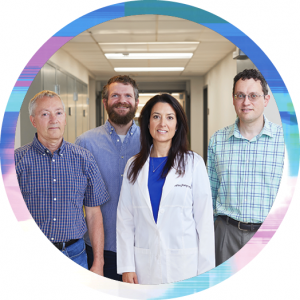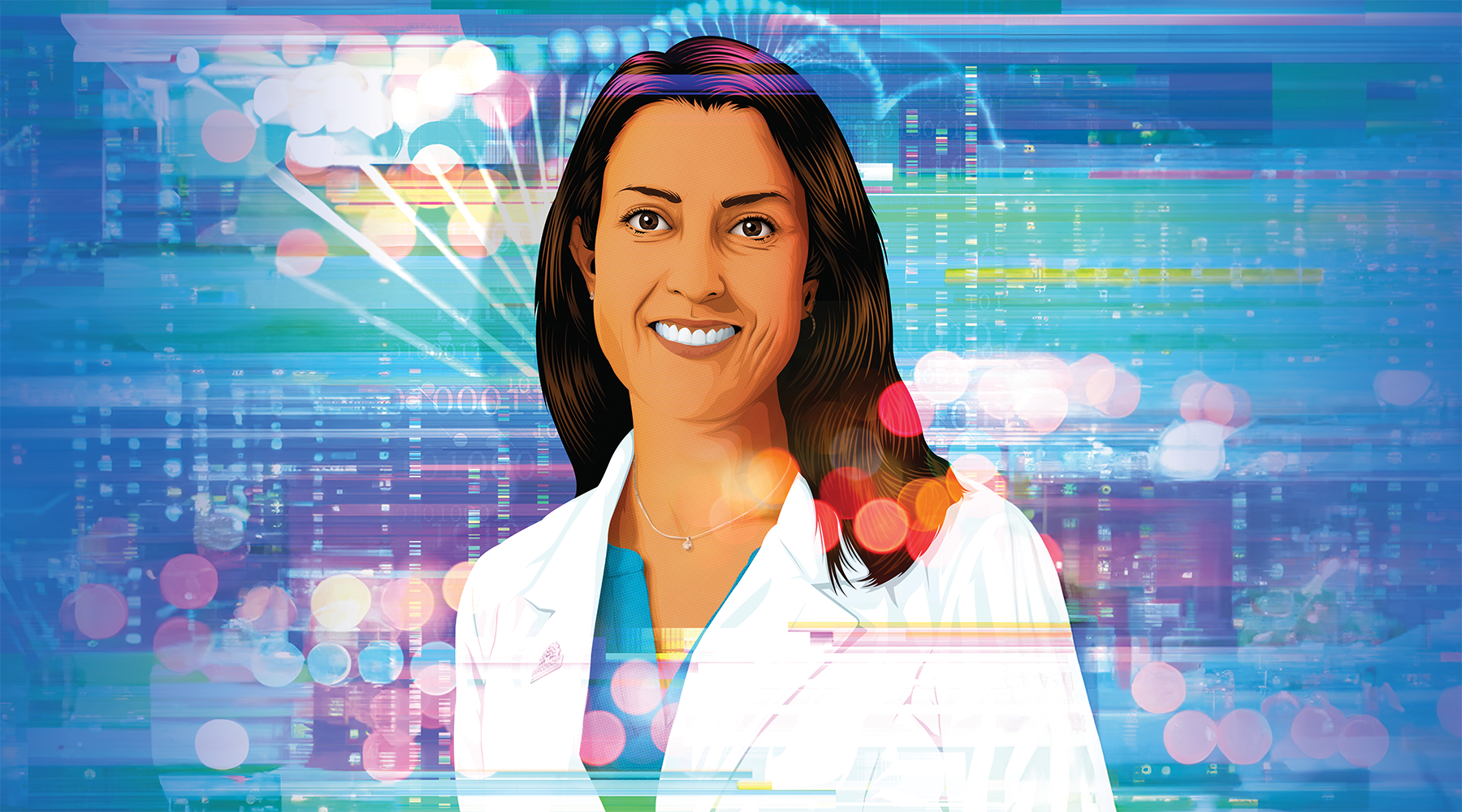Dr. Courtney Montgomery is taking number-crunching at OMRF to new heights
These days, a single experiment in an OMRF lab can generate enough data to fill more than 75 laptops. To make scientific sense of that much information, researchers need mathematicians, computer scientists and enough hardware and software to power a midsized technology company.
Enter Dr. Courtney Montgomery.
Montgomery first came to OMRF in 1995. After graduating from Oklahoma City University with a degree in biology (despite a two-semester detour as a vocal performance major), the Duncan native was preparing to apply for medical school when she took what she thought would be a temporary job as a research technician in an OMRF lab. The team was studying lupus genetics, and soon, she moved from processing blood samples to data analysis.
“It opened my eyes,” Montgomery says. She met a biostatistician, a job she’d never heard of. Biostatisticians apply statistical techniques to research in health-related fields, and Montgomery saw the emerging field as a way to marry her fascination with the human body and her love
of mathematics.

Montgomery decided to pursue a joint career path in biostatistics and genetics. While working full-time at OMRF, she earned her master’s degree in biostatistics at the University of Oklahoma Health Sciences Center. At the same time, she took short courses in human genetics at a half-dozen other institutions. The field was so young that there were just two formal degree programs in the U.S. As a result, scientists like Montgomery often found themselves creating their own training. “I was cobbling together every bit of information I could,” she says.
She earned a Ph.D. in genetic and molecular epidemiology from Ohio’s Case Western Reserve University and joined the school’s faculty to study lupus and cancer genetics. But when OMRF reached out in 2008, she accepted an offer to move her laboratory home.
Since then, her research has focused on sarcoidosis, a rare and sometimes fatal disease that starts in the immune system and causes inflammation. With experiments that can spit out results equivalent to a spreadsheet with 200 million columns and 3 billion rows, she’s also leaned into her biostatistics expertise to develop ways to manage and analyze an ever-growing mountain of biological data.
A runner and self-described “adrenaline junkie” with a love for extreme sports like obstacle courses, bungee jumping and parasailing, Montgomery says tackling complicated math problems takes her to a “happy place.” Thinking about numbers, she says, “is quite calming. It takes all of your focus.”
Montgomery’s reputation as a “go-to” data-cruncher spread among her OMRF colleagues, who face similar issues. “Researchers are now generating massive amounts of data,” says Dr. Bill Freeman, who studies diseases of aging at OMRF. “Dr. Montgomery has the rare skill set that can help make sense of that data and is great at helping other OMRF scientists build these skills to apply to their research.”
Over time, OMRF researchers increasingly turned to Montgomery for assistance processing their own data. As the need grew more acute among faculty members, OMRF decided to create a Center for Biomedical Data Sciences, which would add new computing and data analysis capabilities to support the work of all foundation researchers. Montgomery, says Vice President of Research Dr. Courtney Griffin, was an exciting choice to serve as the center’s first director.
“She brings outstanding data science credentials and a deep knowledge of OMRF,” says Griffin. “She’s devoted her career to working with large and complex data sets, and we’re excited to see her use these skills to accelerate projects across the whole foundation.”
The federal government awarded OMRF funding for construction of the center, which will replace outmoded laboratories built in the 1950s. The project will begin in late 2023. In the meantime, Montgomery is leading a team of data scientists who have already begun to work with numerous OMRF researchers. One of those is Dr. Audrey Cleuren.
Cleuren joined OMRF from the University of Michigan in 2021. She studies how a particular cell type in our blood vessels connects to sepsis and Alzheimer’s. Advanced imaging technology can map precisely where hundreds of genes are expressed in an organ, information that helps her untangle how the cells she’s interested in function.
However, making sense of the data involves a good deal of untangling, too. That’s where Montgomery’s data science team comes in. And they are taking an approach that they hope will provide OMRF’s scientists with the tools they need to allow them to help themselves.
“At other institutions, you might hand over your data and tell them what you need, wait, and then you get a bill. Here, they’re walking us through it, showing us what they did, and helping us do it ourselves,” says Cleuren. “It’s very efficient.”
Montgomery’s group is now working on an artificial intelligence database OMRF scientists will be able to use to find other research related to their results, both internally and externally. The first of these AI tools at OMRF will be devoted to autoimmune disease.
“Making these connections could take a researcher months on their own,” says Montgomery. “Our labs will be able to say, ‘Here’s this thing, tell me what else has been done on this thing.’ It’s going to fast-track scientific discovery.”
—
Read more from the Winter/Spring 2024 issue of Findings
Road Music
The X (and Y) Files
Planting Seeds
Voices: Meg Salyer
Ask Dr. James: Does a lifetime of radiation from medical imaging pose risks to patients?
Pain Killer
Living Legacy



